Search results
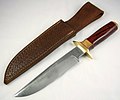 A knife (pl.: knives; from Old Norse knifr 'knife, dirk') is a tool or weapon with a cutting edge or blade, usually attached to a handle or hilt. One of...40 KB (5,309 words) - 15:16, 4 May 2024
A knife (pl.: knives; from Old Norse knifr 'knife, dirk') is a tool or weapon with a cutting edge or blade, usually attached to a handle or hilt. One of...40 KB (5,309 words) - 15:16, 4 May 2024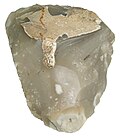 Flint, occasionally flintstone, is a sedimentary cryptocrystalline form of the mineral quartz, categorized as the variety of chert that occurs in chalk...23 KB (2,617 words) - 18:35, 23 April 2024
Flint, occasionally flintstone, is a sedimentary cryptocrystalline form of the mineral quartz, categorized as the variety of chert that occurs in chalk...23 KB (2,617 words) - 18:35, 23 April 2024- A stone tool is, in the most general sense, any tool made either partially or entirely out of stone. Although stone tool-dependent societies and cultures...35 KB (3,968 words) - 15:40, 28 April 2024
 An adze (/ædz/) or adz is an ancient and versatile cutting tool similar to an axe but with the cutting edge perpendicular to the handle rather than parallel...15 KB (1,984 words) - 20:45, 3 May 2024
An adze (/ædz/) or adz is an ancient and versatile cutting tool similar to an axe but with the cutting edge perpendicular to the handle rather than parallel...15 KB (1,984 words) - 20:45, 3 May 2024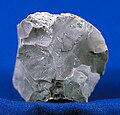 Chert (/ˈtʃɜːrt/) is a hard, fine-grained sedimentary rock composed of microcrystalline or cryptocrystalline quartz, the mineral form of silicon dioxide...35 KB (4,224 words) - 06:11, 9 May 2024
Chert (/ˈtʃɜːrt/) is a hard, fine-grained sedimentary rock composed of microcrystalline or cryptocrystalline quartz, the mineral form of silicon dioxide...35 KB (4,224 words) - 06:11, 9 May 2024 An arrow is a fin-stabilized projectile launched by a bow. A typical arrow usually consists of a long, stiff, straight shaft with a weighty (and usually...31 KB (4,180 words) - 11:34, 8 May 2024
An arrow is a fin-stabilized projectile launched by a bow. A typical arrow usually consists of a long, stiff, straight shaft with a weighty (and usually...31 KB (4,180 words) - 11:34, 8 May 2024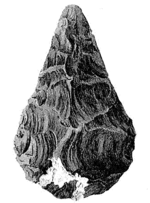 A hand axe (or handaxe or Acheulean hand axe) is a prehistoric stone tool with two faces that is the longest-used tool in human history. It is made from...106 KB (12,491 words) - 15:36, 7 May 2024
A hand axe (or handaxe or Acheulean hand axe) is a prehistoric stone tool with two faces that is the longest-used tool in human history. It is made from...106 KB (12,491 words) - 15:36, 7 May 2024 In archaeological terminology, a projectile point is an object that was hafted to a weapon that was capable of being thrown or projected, such as a javelin...9 KB (919 words) - 16:22, 2 May 2024
In archaeological terminology, a projectile point is an object that was hafted to a weapon that was capable of being thrown or projected, such as a javelin...9 KB (919 words) - 16:22, 2 May 2024 Grime's Graves is a large Neolithic flint mining complex in Norfolk, England. It lies 8 km (5.0 mi) north east from Brandon, Suffolk in the East of England...15 KB (1,657 words) - 17:21, 5 May 2024
Grime's Graves is a large Neolithic flint mining complex in Norfolk, England. It lies 8 km (5.0 mi) north east from Brandon, Suffolk in the East of England...15 KB (1,657 words) - 17:21, 5 May 2024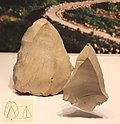 The Levallois technique (IPA: [lə.va.lwa]) is a name given by archaeologists to a distinctive type of stone knapping developed around 250,000 to 300,000...20 KB (2,419 words) - 23:42, 29 April 2024
The Levallois technique (IPA: [lə.va.lwa]) is a name given by archaeologists to a distinctive type of stone knapping developed around 250,000 to 300,000...20 KB (2,419 words) - 23:42, 29 April 2024 Microlith A microlith is a small stone tool usually made of flint or chert and typically a centimetre or so in length and half a centimetre wide. They...36 KB (4,476 words) - 04:54, 6 May 2024
Microlith A microlith is a small stone tool usually made of flint or chert and typically a centimetre or so in length and half a centimetre wide. They...36 KB (4,476 words) - 04:54, 6 May 2024 A metate (or mealing stone) is a type or variety of quern, a ground stone tool used for processing grain and seeds. In traditional Mesoamerican cultures...14 KB (1,742 words) - 07:18, 11 March 2024
A metate (or mealing stone) is a type or variety of quern, a ground stone tool used for processing grain and seeds. In traditional Mesoamerican cultures...14 KB (1,742 words) - 07:18, 11 March 2024 In prehistoric archaeology, scrapers are unifacial tools thought to have been used for hideworking and woodworking. Many lithic analysts maintain that...6 KB (841 words) - 06:28, 14 April 2024
In prehistoric archaeology, scrapers are unifacial tools thought to have been used for hideworking and woodworking. Many lithic analysts maintain that...6 KB (841 words) - 06:28, 14 April 2024 Chalcedony (/kælˈsɛdəni/ kal-SED-ə-nee, or /ˈkælsəˌdoʊni/ KAL-sə-doh-nee) is a cryptocrystalline form of silica, composed of very fine intergrowths of...18 KB (1,845 words) - 19:56, 3 May 2024
Chalcedony (/kælˈsɛdəni/ kal-SED-ə-nee, or /ˈkælsəˌdoʊni/ KAL-sə-doh-nee) is a cryptocrystalline form of silica, composed of very fine intergrowths of...18 KB (1,845 words) - 19:56, 3 May 2024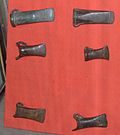 In archaeology, a celt /ˈsɛlt/ is a long, thin, prehistoric, stone or bronze tool similar to an adze, hoe, or axe. A shoe-last celt was a polished stone...3 KB (339 words) - 19:34, 16 September 2023
In archaeology, a celt /ˈsɛlt/ is a long, thin, prehistoric, stone or bronze tool similar to an adze, hoe, or axe. A shoe-last celt was a polished stone...3 KB (339 words) - 19:34, 16 September 2023



















